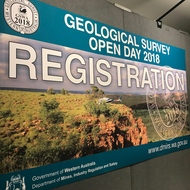Expert presentations feature new, cutting edge data
| Date: | Friday, 02 March 2018 |
|---|
The cutting edge of geoscience was on display at the Department of Mines, Industry Regulation and Safety’s (DMIRS) Geological Survey of Western Australia (GSWA) Open Day 2018 held last week.
Promoted as the premier geological event in WA, the popular annual event lived up to its reputation by showcasing the latest geological information through a range of presentations, demonstrations and poster displays.
DMIRS Geoscience and Resource Strategy Executive Director, Jeffrey Haworth said Exploration Incentive Scheme (EIS) funding allowed GSWA to make significant advances in geoscience and mapping.
“EIS funding has supported many of GSWA’s achievements across mapping, business systems and geoscience, and today is about underlining these efforts and opening them up for discussion,” he said.
A presentation on Frogtech’s new SEEBASE model of the Canning Basin was visually stunning and drew an enthusiastic crowd.
This update of a 2005 study increases the resolution of the Canning Basin depth-to-basement model and incorporates newly acquired geophysical data, surface geology, and information on petroleum wells and mineral boreholes.
Another well-attended presentation featured information on GSWA’s major review of diamond prospectivity in Western Australia.
The review compiled and assessed about 88 000 exploration diamond samples, and the presentation outlined the project’s methodology and results of the indicator minerals, mineral chemistry and spatial prospectivity analyses.
Despite prolific diamond exploration, the study identified regions that are still highly prospective and underexplored, and provides a sound springboard for renewed diamond exploration in Western Australia.
Preliminary data for the North East Canning airborne gravity survey, which was also funded by the EIS, was another major new product released on the day.
The annual extensive poster display highlighted the results of ongoing collaborative research programs funded by EIS, and by the Mineral Research Institute of WA, including mineral exploration targeting with the CSIRO, the Centre for Exploration Targeting and Curtin University as part of the Capricorn Distal Footprints project.
Staff also demonstrated a range of business systems including the latest updates for GeoVIEW.WA, GSWA’s award-winning, state-of-the-art geoscientific web application that is continuously updated with the latest geoscience and resource information.
Along with the displays and demonstrations of online systems, other presentation highlights included:
- The latest results from ongoing mapping, geochronology and geochemistry programs in the Yilgarn Craton.
- An appraisal of the geological setting of the current Pilbara conglomerate-hosted gold nugget ‘gold rush’, and the reality of comparisons to South Africa’s highly endowed Witwatersrand Basin.
- A study on the fingerprinting of gold nuggets in the Kurnalpi Goldfield.
- New work in the Fortescue and Hamersley basins in the Pilbara.
- The innovative use of the composition of zircons from granites as a guide to the prospectivity of in the Pilbara and the Yilgarn.
- Battery metals in Western Australia.
“The pre-competitive geoscience information GSWA publishes is critical in reducing the technical and financial risks involved in exploration, attracts new investors to WA and reinforces the State’s reputation as a global centre for mining and energy excellence,” Mr Haworth said.
Mines and Petroleum Minister Bill Johnston, who launched the event, said he was impressed by GSWA’s continuing commitment to providing world-class products.
“Perth’s geologists and geoscience community clearly hold the open day in high regard, so GSWA will continue to do what it does best – providing the maps, geoscience publications and invaluable data that have earned great respect nationally and internationally,” he said.
Minister Johnston also opened Round 17 of the Co-funded Drilling Program, which is one of the most visible programs within the Exploration Incentive Scheme (EIS).
“The Co-funded Drilling Program focuses on innovative exploration in underexplored greenfield regions, and greatly assists resource exploration in Western Australia,” he said.
“The program is successful, competitive and provides a number of benefits, as it adds to our geological knowledge of the State, helps diminish risks for future explorers, improves exploration efficiency and supports a range of employment opportunities.”

